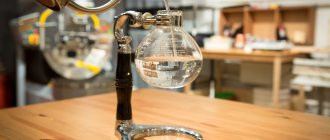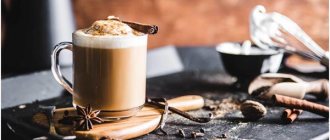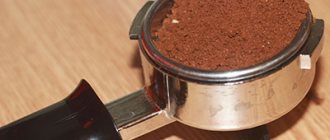The role of fat content
According to experienced baristas, the fat content of milk has virtually no effect on the whipping process. But this indicator is extremely important for the density and durability of the foam. The best fat content of milk for cappuccino is from 3 to 4%. This is the only way to get a thick, sweetish-creamy “cap”, for which the drink is valued.
Optimal taste and texture is provided by a fat content of 3.5%. It is from this milk that cappuccino is prepared in coffee shops.
Any drink connoisseur will notice the use of a low-fat product. The coffee takes on a grayish tint, and the top turns dry and crumbly. Dubious pleasure.
Step-by-step instructions for frothing milk
The procedure for frothing milk can be divided into a number of sequential actions:
- We fill the pitcher with milk, not filling it to the place where its spout begins, about a centimeter.
- We install the cappuccino maker at a forty-five degree angle relative to the pitcher wall. The tube should be placed so that it “looks” slightly away from the center of the vessel and is located approximately at a centimeter depth.
- We immerse the free end of the device in milk and set the device to steam generation mode. The vessel itself should be held by the bottom to control the temperature of the whipped mixture.
- We hold the cappuccino maker, using it to rotate the liquid so that its hissing can be heard.
- Gradually move the device deeper into the vessel, making sure that the hissing does not stop.
- As soon as you feel that the bottom of the pitcher has warmed up, you can move on to the next stage of cooking.
- We immerse the cappuccino maker more deeply. When immersed in depth, the hissing will stop, but the milk should continue to rotate. As a rule, this effect is achieved at approximately a centimeter height from the bottom.
- We heat the milk with steam until you can safely hold the vessel by the handle - to a temperature of approximately +75 degrees or slightly higher.
- Stop the steam supply and remove the tube.
In order for the foam in the cappuccino maker to be homogeneous, you should periodically lightly shake the pitcher, tapping it on the table surface.
The importance of protein and carbohydrates
The next thing you need to find on the packaging is information about the protein content of the milk. Many masters attribute even greater importance to this parameter than to the fat in the composition. Foam made from protein-rich milk is thick, viscous and long-lasting.
If the packaging indicates a protein content of less than 2%, the milk is not suitable for making cappuccino.
Carbohydrates are responsible for the classic sweet flavor of foam. This is mainly lactose, that is, milk sugar. A tasty “cap” is obtained from milk with a carbohydrate content of 4 g or more. Lactose intolerance is a common phenomenon. That's why good coffee shops usually offer a lactose-free alternative with an equally sweet top.
How to pour foam into coffee correctly?
It remains to deal with the last nuance and understand how to pour foam into a cappuccino so as not to spoil the appearance and maintain its airiness. Follow one of the selected options:
- The milk can be slowly poured into the cup, holding the foam with a spoon. Next, pour in the coffee, and lastly place the foam on top;
- At the same time, add hot milk with foam to the cup, then pour coffee down the side in a thin stream;
- If you add sugar or alcohol to cappuccino, do it before adding milk and foam.
The last and most important point. Before creating your favorite drink, warm the cup by pouring boiling water over it from the inside. Otherwise, the foam will partially dissolve and lose density.
Additional selection criteria
It is important that the milk is of natural origin. Powder components in the composition are a compelling reason to refuse to purchase this product. It would seem that whole milk fits the bill. And yet coffee gurus don't use it. Sometimes when heated, a homemade product takes on a “cow” smell. However, coffee masters also avoid store-bought packages with o, “Bio” and “Farmerskoe”.
According to most baristas, UHT milk (which has undergone special heat treatment) is ideal for making cappuccino. There is a reason to listen to expert opinion. A pleasant bonus is the long shelf life of such a product. Regular pasteurized milk is also perfectly acceptable if its composition meets the conditions.
- Don't miss: How many calories are in cappuccino with and without sugar?
Important points:
- milk should not be pre-boiled;
- The liquid is removed from the refrigerator immediately before beating.
The temperature should not exceed 5 ⁰C. Otherwise, either the foam will not work out at all, or it will take a lot of time and effort.
The coffee machine does not make cream: reasons
In fact, there are quite a lot of factors influencing the quality of the cream, and not all of them are related to the operation of the device. In particular, the type of coffee, the method of roasting and grinding it, and the freshness of the beans are directly related to the possibility of obtaining foam.
As for the reasons related to the functional features of your coffee machine, the following can be mentioned:
- Water temperature. Ideally, it should be between 90 and 95 degrees.
- Pressure. If the pump does not provide enough pressure, the cream will not form - most likely, the end result will be coffee that tastes and looks similar to the drink from a regular cheap coffee maker.
- Pressing quality of ground coffee.
- Functional features of the coffee grinder. First of all, this concerns the millstones - they must be sharp. On average, a coffee machine must grind up to 250 kg of beans, after which the millstones must be replaced.
- Grinding It is preferable to use medium grind coffee.
- Design features of the coffee maker. It is highly desirable that it be straight, allowing the ground grains to immediately fall into the horn. This will eliminate the possibility of making stale coffee that is not capable of producing thick foam.
- Horn heating temperature.
- The process of making espresso. Ideally, the machine should extract 40 ml of drink in 30 seconds.
By ensuring that these conditions are met, you can easily enjoy aromatic coffee with thick foam.
Review of the best brands
The consumer needs milk for his cappuccino, and the producer supplies it. Products with the appropriate marking for a narrow purpose are produced by brands such as Rioba, Petmol and others. Some call this simply a smart marketing ploy, others call it a justification for the markup. But it’s hard to argue with the fact that such milk makes an excellent cappuccino.
Below are domestic brands of dairy products for making the perfect foam.
| Name | Fat,% 3.5 | Protein,% 2.8 | Average price for 1 liter, rubles 100 | Notes from reviews | |
| pros | Minuses | ||||
| Rioba (UP) | 3,5 | 2,8 | 100 | The best option for durable, malleable foam | There is no lid or dispenser. Sold only in METRO |
| Parmalat Natura Premium (UP) | 3,5 | 3 | 80 | A universal option for good foam at a low price | Baristas classify the product as medium quality |
| "Petmol" (UP) | 3,2 | 3,7 | 95 | A high proportion of protein gives thickness and viscousness | Low fat content. Rare presence of goods on sale |
| Valio selected, UHT | 3,5-4,5 | 3 | 120 | Persistent foaming, pleasant creamy taste | Expensive |
| "Milk River" | 3,5 | 2,8 | 75 | Whips easily and fluffy; pleasant taste | Low Protein Proportion |
Coffee shops usually stock specially marked products that cannot be found in every store. But in order to thoroughly froth milk for cappuccino coffee in a coffee machine, you can use any proven brand with the required characteristics. For example, at home, “Prostokvashino” (3.5/2.8), “Vkusnoteevo” (3.2/2.8), etc. are suitable.
How to make foam at home
Not all coffee gourmets have a cappuccino maker and coffee machine lying around at home. To be more precise, probably not a single one. How to be in this case? Don’t rush to get upset and run to the nearest coffee shop. You can make the perfect cappuccino yourself, using simple equipment or improvised means.
Blender
To make cappuccino foam using a blender, pour full-fat milk into a small saucepan or measuring cup, based on the calculation for one serving.
Important! The volume of the dairy product should not exceed ½ container.
Next, follow the instructions:
- Heat the milk over low heat (both a microwave and a stove will do);
- As soon as steam appears above the milk, remove from heat;
- then arm yourself with a blender and start whipping hot milk;
- It is necessary to finish whipping when the foam reaches the correct, dense consistency.
French press
The main purpose of a French press is to brew tea and coffee. The mechanism is quite simple, it consists of a glass flask with a metal piston that holds tea leaves and ground coffee below.
To prepare cappuccino, fill the flask with milk to a third of the total volume, and carefully work the piston.
Important! When whipping, be careful and extremely careful; the flask is quite fragile and can break or burst with sudden movement.
If bubbles appear in the milk, continue whisking it until foamy. Smoothly rotate the piston clockwise. Don't forget to constantly tap the flask on the table. As soon as the foam becomes thick enough, stop and add to the cappuccino.
With a fork
If you don’t have any utensils at hand, you’ll definitely have a dinner fork. You can even use it to create cappuccino foam.
Follow these simple steps:
- pour hot milk into a deep container;
- tilt the container and simply whisk the milk with a fork in quick circular movements;
- Remember, choosing this method will require hard work. The beating process will take at least 1.5-2 minutes. In addition, you are unlikely to be able to achieve ideal strength and fluffiness, but you will definitely get just beautiful and tasty foam.
Be sure to read: Coffee and tea in one glass: recipes
Mixer
Whipping milk with a mixer is one of the simplest and most effective ways. Pour the milk product into a suitable enamel container, place it on low heat, and immediately begin whisking at the highest speed.
There is no need to bring the milk to a boil; as soon as foam starts to appear, remove the bowl from the heat. Pour into the finished cappuccino immediately, while hot.
Cappuccino art
In professional circles, creating a pattern on milk foam is called latte art. Most often, cappuccino is used as a basis, since it has the densest and most stable foam. The image is applied with cinnamon, cocoa powder and chocolate; it is also possible to create three-dimensional figures. To apply the design, you can use any available means, even toothpicks.
There are several latte art methods:
- stencil;
- pitching (engraving);
- etching.
The first one is the simplest and is suitable for those who, for example, want to learn how to make a heart on a cappuccino. You can purchase a stencil ready-made or cut it out of cardboard yourself. Pitching consists of smoothly pouring milk from a pitcher onto the surface of coffee foam. The spout should be as close to the surface of the drink as possible to prevent premature mixing of the layers. Well, the last method is etching - drawing with sharp objects.











